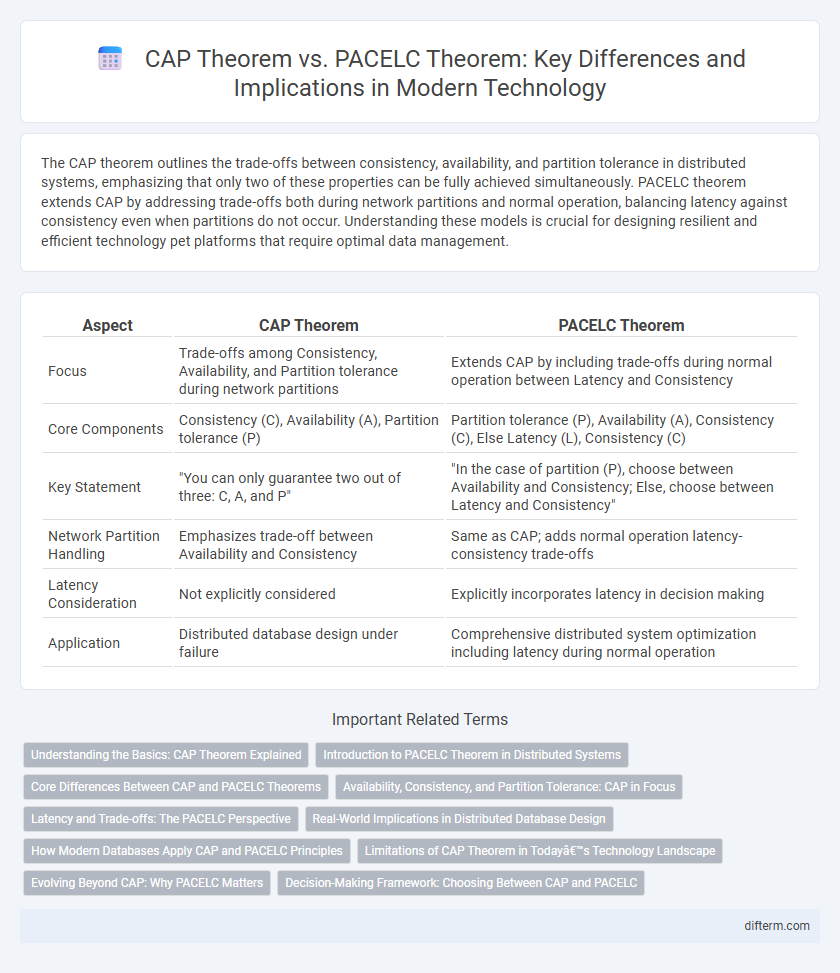The CAP theorem outlines the trade-offs between consistency, availability, and partition tolerance in distributed systems, emphasizing that only two of these properties can be fully achieved simultaneously. PACELC theorem extends CAP by addressing trade-offs both during network partitions and normal operation, balancing latency against consistency even when partitions do not occur. Understanding these models is crucial for designing resilient and efficient technology pet platforms that require optimal data management.
Table of Comparison
| Aspect | CAP Theorem | PACELC Theorem |
|---|---|---|
| Focus | Trade-offs among Consistency, Availability, and Partition tolerance during network partitions | Extends CAP by including trade-offs during normal operation between Latency and Consistency |
| Core Components | Consistency (C), Availability (A), Partition tolerance (P) | Partition tolerance (P), Availability (A), Consistency (C), Else Latency (L), Consistency (C) |
| Key Statement | "You can only guarantee two out of three: C, A, and P" | "In the case of partition (P), choose between Availability and Consistency; Else, choose between Latency and Consistency" |
| Network Partition Handling | Emphasizes trade-off between Availability and Consistency | Same as CAP; adds normal operation latency-consistency trade-offs |
| Latency Consideration | Not explicitly considered | Explicitly incorporates latency in decision making |
| Application | Distributed database design under failure | Comprehensive distributed system optimization including latency during normal operation |
Understanding the Basics: CAP Theorem Explained
The CAP theorem defines three core distributed system properties: Consistency, Availability, and Partition Tolerance, stating that only two can be prioritized simultaneously during a network partition. It emphasizes the trade-offs developers face when designing distributed databases, ensuring data remains reliable and accessible under failure conditions. Understanding CAP helps in choosing system architectures that balance user needs and system constraints.
Introduction to PACELC Theorem in Distributed Systems
The PACELC theorem extends the CAP theorem by addressing trade-offs in distributed systems not only during network partitions but also in normal operation. It states that if a partition occurs (P), systems must choose between availability (A) and consistency (C), while else (EL), they balance latency (L) and consistency (C). This model is essential for designing distributed databases and cloud services, offering a more comprehensive framework for understanding data consistency, availability, and latency trade-offs.
Core Differences Between CAP and PACELC Theorems
The core difference between CAP and PACELC theorems lies in their approach to consistency, availability, and partition tolerance during network partitions and normal operations. CAP theorem addresses trade-offs only when a partition occurs, forcing systems to choose between consistency and availability. PACELC theorem expands on CAP by including latency and consistency trade-offs even when no partition exists, providing a more comprehensive framework for distributed system design.
Availability, Consistency, and Partition Tolerance: CAP in Focus
The CAP theorem defines a distributed system's limitations by emphasizing the trade-offs between Consistency, Availability, and Partition Tolerance during network failures. PACELC theorem extends CAP by addressing latency and consistency trade-offs even when partitions are absent, highlighting that systems balance between these properties continuously, not just under partition scenarios. Availability in CAP is maintained by sacrificing consistency during partitions, whereas PACELC provides a more nuanced view by also considering latency impacts on consistency and availability outside of partitions.
Latency and Trade-offs: The PACELC Perspective
The PACELC theorem extends the CAP theorem by emphasizing latency as a critical factor alongside consistency and availability trade-offs in distributed systems. It explains that even when there is no partition (P), systems must balance latency (L) and consistency (C) or availability (A), highlighting the continuous trade-off beyond network partitions. This perspective helps architects optimize distributed databases by considering latency effects on system responsiveness in addition to partition tolerance.
Real-World Implications in Distributed Database Design
The CAP theorem highlights the trade-offs between consistency, availability, and partition tolerance in distributed databases, emphasizing that only two can be fully achieved simultaneously during network partitions. PACELC theorem extends this by addressing latency and consistency trade-offs even outside partitions, guiding architects to balance performance and reliability based on latency requirements and consistency levels. Understanding these theorems informs real-world database design decisions, impacting data replication strategies, fault tolerance mechanisms, and user experience in globally distributed systems.
How Modern Databases Apply CAP and PACELC Principles
Modern databases implement CAP and PACELC principles by balancing consistency, availability, and partition tolerance under network failures while optimizing latency and consistency trade-offs during normal operation. Systems like Amazon Dynamo prioritize availability and partition tolerance during outages but optimize latency and consistency (PACELC) in stable states, enhancing performance in distributed environments. These adaptive strategies allow databases to maintain robustness, ensure data correctness, and meet user experience expectations in cloud-native architectures.
Limitations of CAP Theorem in Today’s Technology Landscape
The CAP theorem's limitation lies in its narrow focus on consistency, availability, and partition tolerance, neglecting latency and consistency trade-offs during normal operation, which PACELC theorem addresses. Modern distributed systems demand considerations beyond network partitions, emphasizing latency and consistency that CAP cannot fully capture. PACELC enhances system design by incorporating these additional factors, reflecting the complexities of cloud computing and large-scale data management today.
Evolving Beyond CAP: Why PACELC Matters
The PACELC theorem refines the CAP theorem by addressing trade-offs not only during network partitions but also in normal operation, emphasizing latency and consistency across distributed systems. Unlike CAP, which focuses solely on consistency, availability, and partition tolerance, PACELC highlights the inevitable balance between latency and consistency even when partitions do not occur. This nuanced approach offers a more comprehensive framework for designing resilient and efficient cloud architectures in real-world, distributed environments.
Decision-Making Framework: Choosing Between CAP and PACELC
CAP theorem simplifies distributed system design by focusing on trade-offs between Consistency, Availability, and Partition tolerance during network failures. PACELC theorem extends this framework by including latency considerations even when no partition occurs, offering a more nuanced decision-making model. Choosing between CAP and PACELC depends on system requirements for latency, consistency, and availability under both normal and partitioned operations.
CAP theorem vs PACELC theorem Infographic

 difterm.com
difterm.com